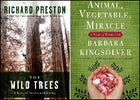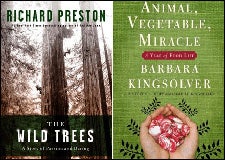The Wild Trees: A Story of Passion and Daring
Want it? Get it
Buyand
at amazon.com.
Richard Preston & Barbara Kingsolver

RICHARD PRESTON
RANDOM HOUSE, $26
THIRTY-FIVE STORIES up in the redwood forests of Northern California and Oregon, the canopy is dripping with lichens and lungworts, crowded with elderberry and salmonberry canes, and teeming with species so rare they’ve yet to earn a name. It’s an ecosystem, bestselling author Richard Preston notes, that until very recently was “one of the last unseen realms of nature on the planet.” In The Wild Trees, Preston leaves the deadly viruses he explored in his true-science potboilers The Hot Zone and The Demon in the Freezer to immerse himself in the subculture of tall-tree climbers. His focus: two resourceful adventure-botanists who use ropes, harnesses, and carabiners to explore these “coral reefs in the air.” Steve Sillet, a moody academic, undertakes 350-foot “ninja climbs” and sleeps in the boughs, suffering multistory whippers in the process. Michael Taylor scraped by for years as a grocery clerk and knife salesman to finance his passion, using homemade tools to scout for “the Ultimate Tree” from the ground. Together they catalog the remaining 300-plus-foot giants, making some of the greatest botanical discoveries of the century, including the Atlas Grove, “the Sistine Chapel of the world’s forests,” and Hyperion, a 379-foot tower in Redwood National Park that now reigns as the world’s tallest tree. Preston’s tale is more than just a paean to tree nerds; he delves skillfully into the pair’s personal lives, chronicling the rocky relationships and professional setbacks that stem, in part, from their all-consuming arboreal passions. “These trees can teach us how we can live,” says Sillet. “We can be hammered and burned, and we can come back and be more beautiful and intricate as we grow.” Preston himself is changed by the trees, becoming one of the few people qualified to ascend these giants, where the deep forest canopy, he writes, is “neither fully solid nor purely air, an ever-changing scaffold joining heaven and earth, ruled by the forces of gravity, wind, fire, and time.”
JASON DALEY
Animal, Vegetable, Miracle: A Year of Food Life
BARBARA KINGSOLVER
(WITH STEVEN L. HOPP AND CAMILLE KINGSOLVER)
HARPERCOLLINS, $27
BY NOW YOU’VE heard it a hundred timeseat your veggies, swear off high-fructose corn syrup, and banish refined flour to the compost pile. But eating fresh, organic produce is expensive, elitist, and inconvenient, right? Not necessarily, argues novelist and new New Agrarian Barbara Kingsolver in her first book-length memoir, Animal, Vegetable, Miracle. Joining bestselling writers Eric Schlosser (Fast Food Nation) and Michael Pollan (The Omnivore’s Dilemma), Kingsolver dresses down the American food complex, signing her family up for a year of eating foods produced on or near their 100-plus-acre patch of Virginia Appalachia. “Strange,” she writes of giving up “industrial food,” “how much it felt like stepping into a spaceship and slamming shut the hatch.” Kingsolver rhapsodizes over heirloom potimarron squash and takes an ax to her heritage BourbonRed turkeys; her husband and two girls help can more than 80 jars of tomatoes and jam. These down-on-the-farm sections are inspiring and generally more compelling than Kingsolver’s occasionally smug tirades against modern food. In the end, the family saves a pile of money (eating for 50 cents per person per meal) and learns to trust their own foodshed (making exceptions only for coffee, grains, and olive oil). The experience, writes the ever-earnest Kingsolver, was like “a purification ritual, to cultivate health and gratitude.”
FLORENCE WILLIAMS


